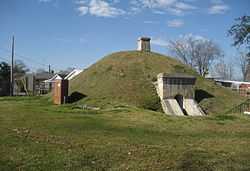Camp Parapet
|
Camp Parapet Powder Magazine | |
 | |
|
The Camp Parapet powder magazine in 2008 | |
 | |
| Location | Arlington St., E of Causeway Blvd., Metairie, Louisiana |
|---|---|
| Coordinates | 29°57′39″N 90°9′20″W / 29.96083°N 90.15556°WCoordinates: 29°57′39″N 90°9′20″W / 29.96083°N 90.15556°W |
| Area | less than one acre |
| Governing body | Local |
| NRHP Reference # | 77000671[1] |
| Added to NRHP | May 24, 1977 |
Camp Parapet was a Civil War fortification at Shrewsbury, Jefferson Parish, Louisiana, a bit more than a mile upriver from the current city limits of New Orleans.
History
The fortification consisted of a Confederate defensive line about a mile and 3/4 long stretching from the Mississippi River northward to Metairie Ridge. (The area further north from the ridge to Lake Pontchartrain was at the time swampland.) This was intended to protect the city of New Orleans from Union attack from upriver. As the Union fleet took the city by sailing in from below, the fortification was never used. After the capture of New Orleans, U.S. forces garrisoned and expanded the fortifications to defend against a Confederate counter-attack, which never came.
Remains
Powder magazine
The only remaining structure of the fortification is the powder magazine, of brick enclosed in an earth mound. It is located off Causeway Boulevard near the American Legion Post 267, preserved in a small park and added to the National Register of Historic Places in 1977.
Cemetery site
Nearby is the historic Shrewsbury (Camp Parapet) Cemetery, the site of the camp's cemetery, where 7,000 Union bodies were once interred before being moved to Chalmette National Cemetery.
See also
References
- ↑ "National Register Information System". National Register of Historic Places. National Park Service. 2010-07-09.
External links
| Wikimedia Commons has media related to Camp Parapet. |
- New Orleans area Forts with information on Camp Parapet.